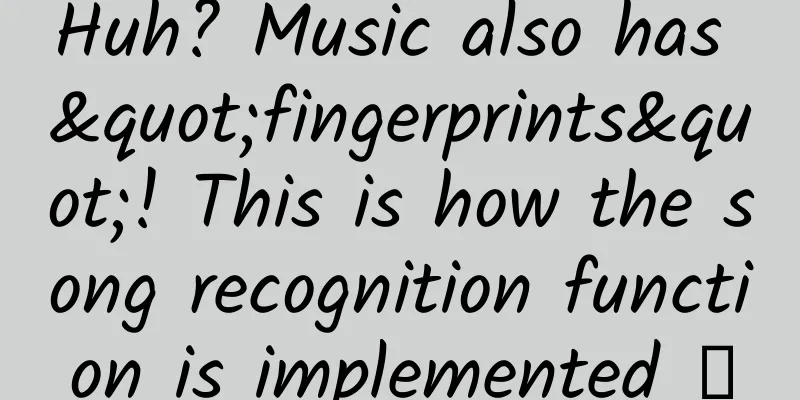Huh? Music also has "fingerprints"! This is how the song recognition function is implemented →

|
Everyone may have had this experience. Hearing a familiar melody But I just can't remember the name of the song At this time, turn on the song recognition function After a few seconds The corresponding song appears on the screen. How does this function work? How can you accurately identify the song title in such a short time? Audio fingerprints are key to identifying songs The key to identifying songs by listening to them lies in audio fingerprinting. Just like a person's fingerprint is unique, each song also has its own unique fingerprint. Audio fingerprint is the digital DNA of the audio signal. Its generation process can be roughly divided into the following steps: The first step in music recognition is to "listen" to the sound. But how does a machine "hear" a song? Sound is essentially a vibration. After being received by the human ear, the human ear will transmit this vibration through the eardrum and other tissues into a signal that the brain can recognize. The principle of a machine listening to music is similar. It converts the vibration of sound into an electrical signal, and then converts the electrical signal into a digital signal that can be processed by a computer. The sound in the real world is an analog signal, which is continuous (like a line), while the digital signal that computers need to process is discrete (like multiple points). Therefore, it is necessary to convert the continuous sound waveform into a discrete digital signal through sampling . The sampling rate determines the capture effect of the signal. The higher the sampling rate, the denser the points, and the more complete the original sound is preserved . The digitized signal after feature extraction will then be sent to the audio processing module for sound feature extraction, including conversion from time domain to frequency domain, especially through Fourier transform (a mathematical transformation algorithm) to decompose the continuous audio signal into components of different frequencies. The time domain signal is the most direct form of sound expression (that is, the waveform we usually see in the recording software), while the frequency domain signal can reflect the frequency components contained in the sound. After the frequency domain analysis, the obtained spectrogram can make the characteristic information of the audio visual. The spectrogram records the frequency and amplitude of each second of the song , and intuitively shows us which frequencies appear in the signal and when, and how their strengths and weaknesses are related . Audio fingerprint generation Based on the features of the spectrogram, we can get the audio fingerprint. The audio is generally divided into several small blocks, and the significant frequency peaks in the audio are extracted. The peak combination of each fragment forms the audio fingerprint of the entire song . Normally, different frequency ranges are processed separately to ensure a balanced analysis of bass, midrange and treble, avoiding confusion or missing certain musical elements. Each song is converted into a unique audio fingerprint, so even different versions of the same song will generate different fingerprints due to differences in frequency, amplitude and time to ensure the most accurate subsequent matching. Finally, when we have a song's "fingerprint", the next step is to find a matching fingerprint in the existing song database to identify the specific song. The song recognition technology converts each audio fingerprint into a hash value (a code) because it is much faster to directly compare the hash value than to compare the entire audio. The software will compare the fingerprint of the user's recording with the fingerprint hash value in the database to find matching songs. Other uses of audio fingerprints In addition to being used to identify songs, audio fingerprint technology can also be applied in the following areas: 1. Personalized music recommendations Feature extraction and matching technology also provides a basis for personalized music recommendations. The recommendation system mines users’ preferences based on music features such as melody, rhythm, and emotion, which not only improves the accuracy of recommendations but also helps users discover more music that matches their tastes. 2. Copyright detection and protection Audio fingerprint technology can also be used for copyright detection and protection, such as detecting whether there are songs with the same content in the media library, detecting whether videos and audio uploaded by users are infringing, and whether a song is used without authorization. 3. Audio playback monitoring For example, when advertisers need to monitor whether television or radio broadcasts advertisements on time and at a certain frequency, the radio station can use this technology to monitor and count. |
<<: Can't help eating? It's not your fault! Maybe there's something wrong with your body.
>>: "Xuanwu" supports Hebei's "Grassland Sky Road"
Recommend
The fresher, the more dangerous! A type of "daylily" on the high green mountains, if eaten incorrectly, it can cause poisoning!
There is a song whose lyrics may be familiar to m...
Summary of 12 methods of traffic promotion
The purpose of drainage is just to increase fans....
Architecture Senior - Diudiu——AIGC|DELL Precision Professional Mobile Workstation AI Drawing Review
Long time no see everyone, I’m Diudiu, the man yo...
Super detailed! iOS 11~14.3 full series of jailbreak tools and fool-proof tutorials released
The jailbreak tool for iOS 11~iOS 14.3 released v...
How much does it cost to join a fitness app in Anshun?
How much does it cost to join a fitness app in An...
Science in the Week | Wild boars to be removed from the three lists
2021 Week 50 Issue 15 Total Issue 361 2021 is com...
These 3 types of toothpaste are included in the "blacklist", do you have any at home?
When you wash your face and brush your teeth in t...
How much does it cost to be an agent of Wuxi Home Improvement Mini Program? What is the price of being an agent for Wuxi home improvement mini program?
Why should you be an agent for WeChat Mini Progra...
Advertising overview in May, inventory of top advertisers for App and brand promotion
This article shares with you an overview of the t...
The whole process of product operation from 0 to 1
The main purpose of this article is to share my p...
Samsung Galaxy Fold review: An imperfect folding screen, a promising new form factor
Ten years ago, the interaction method of smartpho...
How to analyze the 4 characteristics of online hot spots through user psychology
With the Internet so developed today, every hot s...
How to use scroll offset of ScrollView in SwiftUI
Preface Now that WWDC 24 is over, I decided to st...
Case Study: Review of Tmall’s 21-Day Vitality Plan
From the news on April 10th that Yi Yang Qianxi w...
Netgear has launched a new product line, the Orbi, which can split into two parts. Will it attract you if you don’t have a house?
If someone tells you, "My router is NETGEAR....









